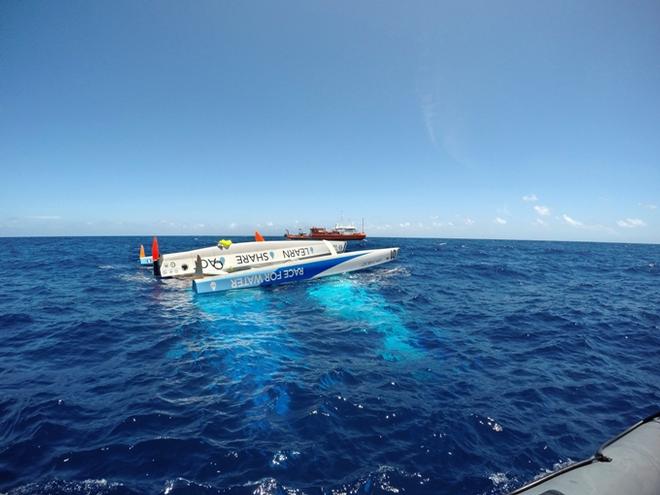Race for Water Odyssey demonstrates widespread plastic pollution
by Media Race for Water on 29 Sep 2015

Capsizing of the MOD70 Race for Water Race for Water 2015 / US Navy
Race for Water Odyssey (R4WO) has published its initial observations drawn from data collected during its first expedition to establish the first comprehensive assessment of plastic pollution in the world’s oceans. The combined analysis of the Ecole Polytechnique Federale de Lausanne (EPFL) and R4WO has concluded that plastic pollution is widespread and in large quantities.
During the first six months of the expedition, R4WO took samples from beaches on several different islands located in waste accumulation areas in the North Atlantic Ocean and the North and South Pacific (also known as gyres or waste vortex).
EPFL’s Central Environmental Laboratory is currently running a typology analysis of the plastic samples collected from the different beaches. After this initial phase, the samples will be handed over to the University of Bordeaux in France to run eco toxicity tests on fish eggs, then to the HEIA in Fribourg, Switzerland, where they will study the absorbed pollutants in the micro plastic. In addition, R4WO sent plankton samples collected during the expedition to the USA in late August as part of the Plankton Planet science project.
Alarming preliminary results
Preliminary results from the first three stopovers in the Azores, Bermuda (North Atlantic waste accumulation zone) and Easter Island (South Pacific) delivered some alarming initial findings. For the moment, these findings are based on the categories of debris sampled; further studies of the types of plastic collected are yet to be completed. Firstly, the samples collected demonstrated that all three islands are polluted by macro (>2.5mm) and micro (<5mm) debris. Plastic pollution is widespread; it can be shaped by local influences and it varies in terms of quantity. Several parameters must be considered – on one hand, local sources of waste, beach cleaning operations and the proximity of the continents and large urban centres can influence macro waste concentration. On the other hand, the proximity of the centre of the gyres and the highly variable nature of weather systems and ocean conditions also seem to affect the quantity of micro debris collected. Plastic makes up the vast majority of macro waste; it represented 84% of waste collected in the Azores, 70% in Bermuda and 91% on Easter Island.
Hard plastic made up between 40 and 74% of the total amount of macro plastic, fishing line and rope was the next biggest category, followed by foam, capsules, film and cigarette filters. Maritime and fishing activities account for the rope and fishing line and Bermuda was more affected by this type of pollutant than the Azores or Easter Island. Hard plastic also made up the majority of the micro plastic findings; this is explained by the fact that macro plastic is broken down by waves and solar radiation. The next biggest category of micro waste is fishing line. In the Azores and on Easter Island, ‘pellets’, another type of micro plastic, stood out. Frederic Sciacca, scientific advisor to R4WO, explains:
“Pellets are the basis of all industrial plastic production, this waste generally derives from container ships losing their cargo in bad weather, however, it can also come from poorly controlled industrial activities on the continent. Loose pellets are very easily swept up by rainwater run off and deposited in rivers and then the oceans. These pellets can be a real scourge; especially on Easter Island where they made up 36% of the total collected micro waste' he said.
Drones and macro waste – experimental technology
For the first time, an ‘eBee’ drone from SenseFly, a Swiss company, is being used as part of a large-scale environmental project to create high-resolution maps of beaches and offshore areas studied. The aim is to assess the capabilities of this innovative technology with a view to one day developing a powerful tool that detects macro waste. After a few initial adjustments, the material produced by the drones has been used to create an image bank that records and identifies waste, in particular the plastic macro waste that litters the shorelines. These images are currently being analysed by Duke and Oregon State Universities.
The environmental expedition, Race for Water Odyssey, continues despite the recent capsize of its flagship off the Chagos Archipelago on 12 September. The next phase will take place on Rodrigues Island from the 26-30 September and will provide additional data on waste concentration in the Indian Ocean. In parallel, analysis continues at the EPFL laboratory, at the University of Bordeaux and at the HEIA in Fribourg, while Duke and Oregon State Universities continue processing the aerial images.
If you want to link to this article then please use this URL: www.sailworldcruising.com/138951